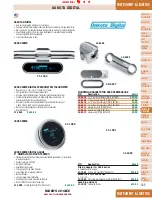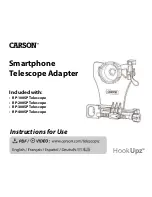
delivering the required amount of current needed for the trailers
braking system (Refer to the tow vehicle and trailer owners manuals).
If the brake control power circuit (+) does not meet the demand, wire
directly to the battery.
1.
Locate the vehicles factory brake control
connector under the dash in line with the brake
pedal (Fig. 1). The connector will be similar to
that found on the Brake Control Wiring
Harness and designed to mate with it (Fig. 2).
Refer to the vehicles owners manual for
additional information in locating this connector.
2.
Plug the Brake Control’s harness mating
connector into the vehicle harness connector,
ensuring that the locking tabs engage.
3.
Confirm correct operation with a load
simulating tester or a properly equipped trailer.
LED DISPLAY
Once the wiring is complete, the LED display will indicate one the
following, illustrating the brake controls activity:
•
Power Conservation Mode - No Activity for 3
1
⁄
2
Hrs. or
Longer. The Journey HD will Become Instantly Active
when the Brake Pedal is Depressed.
•
No Trailer Connected - Journey HD is Receiving Power
and is Active.
•
Trailer is Connected - Journey HD is Receiving Power
and is Active.
Congratulations on your
purchase of the Journey HD
TM
trailer brake control module.
Solid state dependability and polarity protection are just a few
features the Journey HD offers that are not found on many other
brake controls.
FEATURES
• The Journey HD provides an easy to read digital display which
communicates a full range of diagnostic information and allows for
precise brake output adjustment.
• The Journey HD Electric Brake Control is polarity protected. If the
positive (+) and negative (-) power leads are reversed, the unit
isolates itself from the power input and protects itself from damage.
• Easy Precise Setup - Separate thumb wheel controls for output
power and ramp (reaction) time provide full setup adjustability.
• Stop Lamp Activation - When applying the trailer brakes by
utilizing the manual slider alone, the Journey HD will supply power
to the trailer’s brake lights.
• Mounts Anywhere - Leveling of the Journey HD Electric Brake
Control is not required. This electronic unit is designed to operate
in a wide range of positions.
• The Journey HD Electric Brake Control supports 1 to 4 axle
trailers (2 to 8 brakes) and is ideal for use on trailers with
electronically activated hydraulic braking systems.
• Full Power Manual Over Ride - The Journey HD’s Manual
Activation Lever provides Full Available Power to the trailer brakes
when applied.
3.
Using a
1
⁄
8
” drill bit, drill the holes marked in step 2 into the
mounting surface.
Caution: Ensure that the area directly behind the mounting
surface is clear of obstructions that may be damaged while
drilling.
4.
Using a screwdriver or
1
⁄
4
” nut driver, secure the
bracket to the vehicle with
the two
1
⁄
4
” self tapping
screws (provided). Take
care not to strip the holes
by over-tightening the
screws.
5.
Mount the Journey HD
electric brake control into the bracket using two
1
⁄
4
” self tapping
screws (provided) (fig. 4).
Caution: Do not use longer screws than those provided.
WIRING
Note: Read all instructions thoroughly before beginning.
Ensure the tow vehicles brake control power circuit (+) is capable of
CONTROLS / COMPONENTS
1.
LED Display
2.
Output Setting Knob
3.
Ramp Time Setting Knob
4.
Manual Activation Lever
5.
Harness Mating
Connector
MOUNTING
Note: Read all instructions thoroughly before beginning.
The Journey HD electric brake control can be mounted in a variety of
positions, making it easily and comfortably accessible from the
driver’s position of most any tow vehicle. The unit is designed to be
mounted horizontally or vertically, at any angle above or below the
dash (fig. 1, 2 & 3)
1.
Determine an appropriate
mounting location that is easily
accessible from a comfortable seated
driving position within 36” from the
vehicle’s factory harness connector.
Note: The brake control unit
must be securely mounted to a
solid surface (i.e. onto or
beneath the vehicles dash) within easy reach of the driver.
2.
Place the mounting bracket into the desired position on the
vehicle and mark the location of the bracket mounting slots.
1.
2.
4.
5.
fig. 1
Above Dash Mounting
•
Manual Lever Applied - No Trailer Connected
(Applies to Manual Lever Only)
•
Manual Activation Lever or Vehicle Brakes
Applied - Trailer is Connected (Output
Reading is Based on Output Intensity
Setting and Position of Manual Lever, if Applied)
TROUBLESHOOTING
In addition to indicating output power and Load Range settings, the
Journey HD is capable of communicating operating errors via its LED
display.
•
Trailer brake circuit may be lost or intermittent.
Check the trailer connector for a secure dry connection.
Note:
It is normal for the Journey HD Brake Control to
flash
OC
for a few moments after the circuit is disconnected.
•
Short Circuit Situation - The trailer brake circuit may be
shorted to ground. Check for improper wiring. The unit
will reset once the situation is corrected.
•
Charging System Error - There may be a charging
system problem or an inadequate connection to the tow
vehicle’s battery. The unit will reset once the situation is
corrected.
OUTPUT & RAMP TIME SETTINGS
Prior to towing, the Output Power must be adjusted for the individual
trailer being towed.
1.
Connect the desired trailer to the tow vehicle.
2.
Start the tow vehicle to ensure sufficient battery power is being
supplied to the brake control. While parked, depress the brake pedal
and rotate the Output Setting Knob located on the left side of the
control until the LED display indicates
30
.
3.
Continue to press on the brake pedal and rotate the Ramp Time
Setting Knob located on the right side of the control until the LED
display reads
-5
.
4.
In an open and controlled area, release the brake pedal and drive
forward on a dry level surface at approximately 20 mph. Ensure that
ample distance is available for safe braking and slowly apply the
brake control’s Manual Activation Lever until the trailer brakes fully
engage to stop the trailer. Note the output reading on the LED display.
Caution: Full activation of the manual lever will apply
100% Power to the trailer brakes.
5.
Release the Manual Activation Lever and rotate the Output Setting
Knob until the LED displays the same reading as that noted in step 4.
6.
Once again drive forward at approximately 20 mph. Ensure that
ample distance is available for safe braking and apply the brake
pedal.
If Trailer Brakes Lock Up:
Reduce power to the trailer brakes by rotating the Output Setting
Knob counter-clockwise. Reduced power is indicated by a decreasing
readout (smaller number) on the LED display.
If Trailer Braking was Insufficient:
Increase power to the trailer brakes by rotating the Output Setting
Knob clockwise. Increased power is indicated by an increasing
readout (larger number) on the LED display.
7.
Continue to repeat steps 5 and 6 until the desired power output
fig. 4
has been achieved. The brake control output should be just below the
point where the trailer wheels lock up, yet there is sufficient force to
allow for maximum brake force.
8.
Once the initial output power level has been established, adjust
the Ramp Time by performing additional low speed stops (20 mph)
utilizing the tow vehicles brake pedal to ensure smooth combination
braking between the tow vehicle and the trailer.
If Trailer Brakes are Lagging the Vehicle:
Rotate the Ramp Time Setting Knob clockwise to increase the speed
of trailer brake application.
If Trailer Brakes are Overly Aggressive:
Rotate the Ramp Time Setting Knob counter-clockwise to decrease
the rate of trailer brake application.
9.
Once the desired Ramp Time has been established, it may be
necessary to re-adjust the Power Output Setting (steps 4-5).
Caution: Increasing the power output setting or ramp time
setting should NOT be utilized as an option to adjusting or
repairing trailer brakes.
NOTE:
In certain situations trailer brakes may not be capable of
locking up. This situation can be associated with brake wear, overall
trailer weight, trailer length and/or wire gauge. If the trailer brakes will
not lock up during the setup procedures, it is recommended that all
components of the braking system are checked to ensure safe towing.
Caution:
On some vehicles, manual operation of trailer brakes will
not override the tow vehicle’s cruise control operation.
3.
fig. 2
Below Dash Mounting
fig. 3
Below Dash Mounting
OPERATING TIPS
•
Light pressure on the brake pedal will activate the trailer brakes
without applying the tow vehicle brakes. This is useful when
traversing grades, anticipating stops or correcting trailer sway.
•
Periodic adjustment of the Ramp Time and Output Setting Knobs
may be necessary to compensate for trailer loading, brake wear and
varying road conditions.
•
Application of the trailer brakes by utilizing either the brake pedal
or Manual Activation Lever will illuminate the trailer’s brake lights.
•
On some vehicles, the use of hazard flashers may pulse the trailer
brakes. To reduce this effect, adjust the Ramp Time to a lower setting,
or install a pulse preventer.
BENCH TESTING
The Journey HD can be field tested should correct operation be suspect.
Remove the unit from the tow vehicle and wire to a 12 volt automotive
battery and #1156 automotive bulb as illustrated in figure 6.
Wiring
1.
Attach the unit’s Blue wire to one side of a standard #1156
12 volt automotive bulb by using a socket or by soldering the wire to
the bulb.
2.
Attach a length of 16 ga. or larger wire to the other side of the
#1156 bulb.
3.
Attach the White wire to the Negative (-) battery terminal.
4.
Attach the Black wire to the Positive (+) battery terminal.
Note:
Do not attach the unit’s Red wire or the bulb to the battery at
this time.
Caution: Do NOT touch the brake control’s RED
wire to Ground (-) as this will destroy the unit.
Testing
1.
Rotate the Output Setting Knob clockwise and the Ramp Time
Setting Knob counter-clockwise (each toward the rear of the unit.
2.
Move the Manual Activation Lever to the left. The unit’s LED
display should temporarily indicate .9
(-.9)
.
3.
Connect the light bulb to the Negative (-) battery terminal as
illustrated in fig. 6. Move the Manual Activation Lever to the left. The
LED display should increase from approximately
05
to
99
and the
light bulb illumination should increase in intensity in conjunction
with the LED reading.
4.
Release the Manual Activation Lever. The LED display should
now display only decimal points
(. .)
.
5.
Attach the Red wire to the Positive (+) battery terminal. The unit’s
LED display will indicate an output reading beginning at
05
and
slowly increase to
99
. The light bulb illumination should increase in
intensity in conjunction with the LED reading.
6.
Slowly rotate the Output Adjustment Knob counterclockwise
toward the front. the LED display should smoothly decrease from
99
to
05
. Note: The lightbulb intensity should decrease in conjunction
with the LED display.
7.
Rotate the Output Setting Knob to the rear of the control so that
the display reads
99
and rotate the Ramp Time Setting Knob
clockwise to the front of the control. the LED display should change
mode to indicate ramp time, moving from
-0
to
-9
as the thumbwheel
is rotated.
8.
Disconnect and reconnect the red wire from the battery’s positive
(+) terminal. The light bulb should light brightly with a minimal delay.
9.
If the Journey HD brake control does not function as described in
the steps above, return the unit to an authorized distributor for service
or replacement.
SERVICE & SUPPORT
• For questions regarding installation and usage, call (800) 423-6726.
30450-998 - Rev B 06/13/06
Tools Required:
• Drill with 1/8” Bit
• 1/4” Nut Driver
• Phillips Screwdriver
• Probe Style Test Light
Applications:
1994-1996 Ford Bronco
1994-2004 Ford F-Series Pickups
2000-2004 Ford Excursion
2005-Current Ford F-150 & F-250 LD
1997-Current Ford Expedition
1992-Current Ford Full Size Vans
2002-Current Ford Explorer
1995-03
Ford Windstar
(w/Factory Tow Package)
(w/Factory Tow Package)
2002-Current Mercury Mountaineer
(w/Factory Tow Package)
30450
© 2006 Valley Industries
INSTALLATION INSTRUCTIONS
+
-
BATT (BLACK)
GND (WHITE)
12 VOL
T
TOW VEHICL
E BA
TTER
Y
WARNING:
READ AND OBEY
ALL WARNINGS AND CAUTIONS
PRINTED ON TOW VEHICLE BATTERY
BRAKES (BLUE)
STLT (RED)
ONLY CONNECT BULB TO
NEGATIVE (-) TERMINAL
AS NEEDED
STANDARD 12V #1156
AUTOMOTIVE BULB
(USE SOCKET OR SOLDER
WIRES TO BULB)
DO NOT CONNECT RED WIRE
TO POSITIVE (+) TERMINAL
UNTIL STEP 5.
JOURNEY HD
BRAKE
CONTROL
fig. 6
Fig. 1
Fig. 2
TO
0C
0 5 99
(Blank)
(Flashing)
0C
SC
C S






























